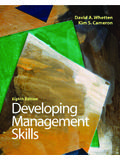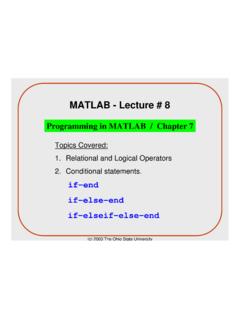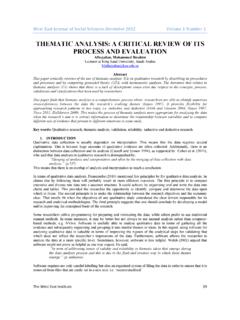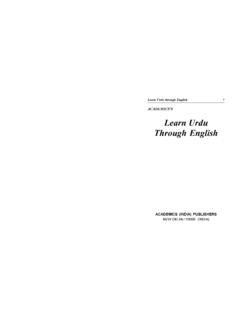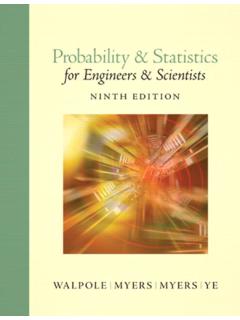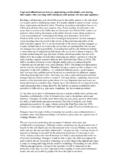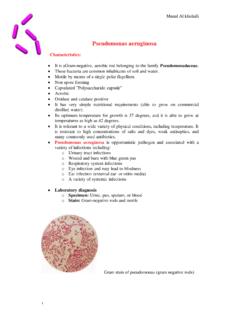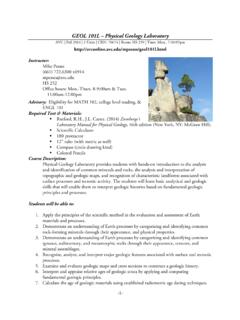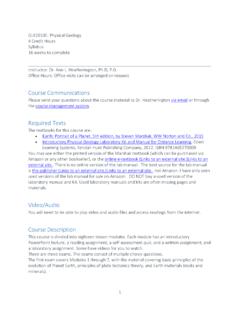Transcription of STRUCTURAL GEOLOGY LABORATORY MANUAL
1 STRUCTURAL GEOLOGY LABORATORY MANUALT hird EditionDavid T. AllisonAssociate Professor of GeologyDepartment of GEOLOGY and GeographyUniversity of South AlabamaTABLE OF CONTENTSLABORATORY 1: Attitude Measurements, True and Apparent Dips, and Three-Point 1-1 Reference system .. 1-1 Attitude of 1-1 Attitude of 1-3 The Pocket Transit .. 1-4 Magnetic 1-5 Measurement of Planar Attitudes with the Pocket 1-5 Measurement of Linear Attitudes with the Pocket 1-6 Locating Points with a Pocket Transit .. 1-7 True and Apparent Dip Calculations .. 1-7 Three Point 1-9 EXERCISE 1A: Apparent Dip and Three-Point Problems .. 1-13 EXERCISE 1B: Apparent Dip and Three-Point 1-15 LABORATORY 2: Stereographic Projections I .. 2-1 Stereographic Projections .. 2-1 Elements of the Stereonet.
2 2-1 Plotting Planes and Lines on the Stereonet .. 2-2 Solving Problems with the 2-2 EXERCISE 2A: Stereographic Projections 2-7 EXERCISE 2B: Stereographic Projections I .. 2-9 LABORATORY 3: Rotational Problems with the Stereonet.. 3-1 Plotting the Pole to a Plane .. 3-1 Fold Geometry Elements .. 3-1 Finding Paleocurrent Direction from Crossbed Data .. 3-2 Rotational fault 3-9 EXERCISE 3A: Rotations with the Stereonet.. 3-17 EXERCISE 3B: Rotations with the Stereonet.. 3-19 Types of Stereonets .. 4-1 Constructing contoured 4-1 Interpretation of Stereograms .. 4-3iiAnalysis of Folding with 4-4 Problems Associated with Fold Analysis on the Stereonet .. 4-5 EXERCISE 4A: Contoured Stereograms and Interpretation of Folded Data.. 4-6 EXERCISE 4B: Contoured Stereograms and Interpretation of Folded Data.
3 4-12 LABORATORY 5: Campus Geologic Mapping 5-1 Mesoscopic 5-1 Megascopic Structure Symbols .. 5-2 Pace and Compass 5-3 EXERCISE 5: Geologic Map and STRUCTURAL Analysis General Instructions .. 5-5 EXERCISE 5A Geologic Map and Stereonet 5-5 EXERCISE 5B Geologic Map and Stereonet Analysis .. 5-7 LABORATORY 6: Geologic Map & Cross Section Field Project .. 6-1 EXERCISE 6A: High Fall Branch Geologic Map & Cross-Section .. 6-2 EXERCISE 6B: Tannehill Historical and Vicinity Geologic Map & 6-5 LABORATORY 7: Thickness and Outcrop Width Problems .. 7-1 Thickness of 7-1 Apparent thickness in a drillhole .. 7-3 EXERCISE 7A: Thickness and Outcrop Width Problems .. 7-4 EXERCISE 7B: Thickness and Outcrop Width Problems .. 7-5 LABORATORY 8: Outcrop 8-1 Outcrop Prediction.
4 8-1 Special Cases .. 8-1 General Solution for Outcrop Prediction .. 8-2 EXERCISE 8A: Outcrop Prediction .. 8-7 EXERCISE 8B: Outcrop Prediction .. 8-9 LABORATORY 9: Stereographic Statistical 9-1 Least-squares Vector of Ramsay (1968).. 9-2 Least-squares Cylindrical 9-2 Least-squares Conical Surface of Ramsay (1968).. 9-3 Goodness of Fit 9-7iiiEXERCISE 9A: Stereograms and Statistical Techniques .. 9-10 EXERCISE 9B: Stereograms and Statistical Techniques .. 9-13 LABORATORY 10: Stress 10-1 Stress Field 10-1 Mohr Circle 10-1 Constructing the Mohr Circle Graph .. 10-3 Determining the Attitude of Stress Axes and Fracture 10-3 Mathematical Basis for Mohr Circle .. 10-4 EXERCISE 10: Mohr Circle and Stress Calculations .. 10-6 LABORATORY 11: Strain 11-1 Strain Analysis.
5 11-1 Use of the Hyperbolic Net (De Paor's Method).. 11-2 Plotting the Attitude of the Finite Strain 11-3 Solving for the Dimensions of the Finite Strain 11-4 EXERCISE 11: Strain 11-7 LABORATORY 12: Fault Displacement 12-1 Introduction to Fault 12-1 Apparent Translation (Separation) .. 12-1 Net Slip .. 12-2 Rotational Faults .. 12-3 EXERCISE 12: Fault Solutions .. 12-4 LABORATORY 13: Down-plunge Fold 13-1 13-1 Constructing the Down-Plunge Profile 13-1 EXERCISE 13: Fold Projection .. 13-5 LABORATORY 14: Constructing Geologic Cross-sections from Geologic Maps.. 14-1 Exercise 14A: Geologic Cross-Sections .. 14-5ivLIST OF FIGURESF igure 1-1: Example problem 1 solution in spreadsheet form.. 1-8 Figure 1-2: Example problem 2 solution in spreadsheet form.
6 1-9 Figure 1-3: Diagram of a three-point problem 1-9 Figure 1-4: 3-point problem example in a 1-11 Figure 1-5: Spreadsheet for intersecting planes problem.. 1-12 Figure 1-6: Map for problem 5.. 1-14 Figure 1-7: Topographic map of the USA campus with 3 contact points A, B, and 1-17 Figure 1-8: Geologic map of a portion of the Dromedary Quadrangle, Utah.. 1-18 Figure 2-1: Example apparent dip problem worked with NETPROG.. 2-4 Figure 2-2: Example Strike and Dip Problem worked in NETPROG.. 2-5 Figure 2-3: Example intersecting planes problem.. 2-6 Figure 2-4: Equal-area (Schmidt) stereographic lower-hemisphere projection.. 2-11 Figure 3-1: Example crossbedding paleocurrent problem.. 3-4 Figure 3-2: Example unfolding fold problem.. 3-8 Figure 3-3: Rotational fault example.
7 3-12 Figure 3-4: Alternative MANUAL rotational fault example.. 3-13 Figure 3-5: Example Drill Core 3-14 Figure 3-6: Example drill core problem 3-15 Figure 4-1: Map for problem 4-14 Figure 4-2: Counting net (equal area).. 4-15 Figure 7-1: Cross-section of thickness problem.. 7-2 Figure 7-2: Cross-section of depth problem.. 7-3 Figure 8-1: Example of horizontal contacts exposed in a 8-1 Figure 8-2: Example of geologic Rule of V s .. 8-2 Figure 8-3: Initial setup of outcrop prediction example 8-5 Figure 8-4: Final solution of example outcrop prediction problem.. 8-6 Figure 8-5: Topographic map for problem 8-10 Figure 8-6: Topographic map for problem 8-11 Figure 8-7: Topographic map for problems 3 and 8-12 Figure 8-8: USA campus topographic 8-13 Figure 9-1: Examples of eigenvector axial lengths.
8 9-5 Figure 9-2: Example of data set that is normally distributed about a least-squares cylindricalsurface according to the chi-square 9-9 Figure 10-1: Example of the Mohr stress circle with fracture envelop.. 10-2 Figure 10-2: Actual physical test specimen for Mohr circle 10-3 Figure 11-1: Simple shear of initially random ellipsoidal pebbles to form a preferred orientationof strain 11-1 Figure 11-2: Plot of strain axes and foliation.. 11-3 Figure 11-3: Undeformed and deformed strain marker reference used for derivation of 11-5 Figure 11-4: Scanned photograph of deformed ooids in 11-9 Figure 11-5: Tracing of the deformed ooids in Figure 11-4. Use this to calculate RF and . 11-10 Figure 11-6: Tracing of deformed pebbles in Cheaha Quartzite. Two parallel faces of the samesample (CA-23) are displayed.
9 11-12 Figure 11-7: Hyperbolic stereonet.. 11-13 Figure 12-1: Example of traces of rotated dikes A and 12-3 Figure 12-2: Calculation of rotational axis position.. 12-4 Figure 12-3: Map for problem 2.. 12-6 Figure 12-4: Map for problem 3.. 12-8 Figure 13-1: Down-plunge projection 13-4 Figure 13-2: Map for problem 1 13-6 Figure 14-1: Example of apparent dip calculation for a vertical cross-section.. 14-2 Figure 14-2: Example of the geometry of plunging folds and 14-3 Figure 14-3: Geologic Map of the Wyndale and Holston Valley Quadrangles, 14-6 Figure 14-4: Geologic cross-sections of the Wyndale and Holston Valley Quadrangles, 14-7viLABORATORY 1: Attitude Measurements, True and Apparent Dips, and Three-Point Reference system(A) Geological structures are represented by one or more lines or planes.
10 (B) A line can be defined in three-dimensional space by its angle with three orthogonalaxes. A plane can be represented by its normal, which itself is a line.(C) Maps contain two horizontal references: Latitude and Longitude (N-S, E-W)(D) The third reference axis is a vertical line.(E) Geologists typically orient structures with reference to the horizontal (strike, bearing,trace, trend) and the vertical (dip, plunge, inclination).(F) Specifying the orientation or attitude relative to the horizontal and vertical referenceswill specify completely the three-dimensional orientation of a line or plane.(G) Orientation within the horizontal reference plane (map) is read relative to a compassdirection (north, south, east, west) in units of degrees.(H) Orientation relative to the vertical is described simply as the angle measured from thehorizontal plane to the plane of interest, this measurement being made in a vertical angle ranges from 0 to Attitude of Planes(A) Bedding, cleavage, foliation, joints, faults, axial plane are some of the geologicalstructures that are represented as a plane.

